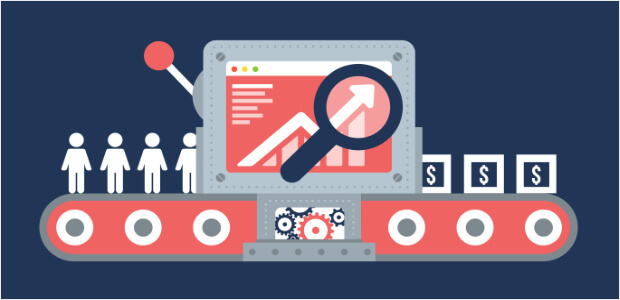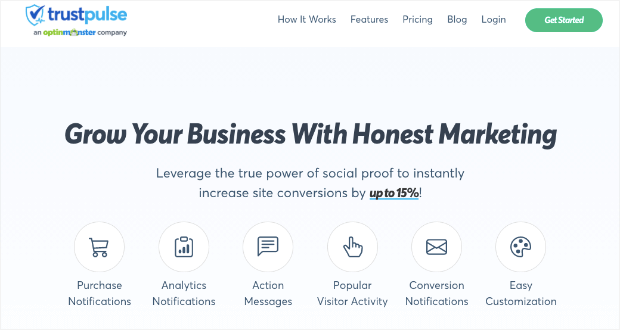Are you struggling to determine what is a good conversion rate and how it impacts the success of your online business?
Understanding the ideal conversion rate is crucial for assessing the effectiveness of your marketing campaigns and optimizing your sales funnel.
In this beginner-friendly article, we’ll break down the concept of conversion rate and discover how to calculate your own. We’ll also define what a good conversion rate is (industry average) and explore strategies to increase it.
Let’s take a look!
- What Is a Conversion Rate?
- What Is a Good Conversion Rate?
- How to Improve Your Conversion Rate
- Conclusion: What’s a Good Website Conversion Rate?
What Is a Conversion Rate?
In simple words, a conversion rate refers to the percentage of website visitors or potential customers who complete a desired action, such as:
- making a purchase,
- creating an account,
- filling out a form (a lead), or
- subscribing to a newsletter.
It measures the potency of a marketing campaign or website in converting visitors into customers or leads.
A higher conversion rate indicates that more visitors are successfully completing the desired action, while a lower conversion rate suggests room for improvement.
Read the 9 Expert Tips on How To Convert Traffic Into Sales.
How to Calculate Conversion Rate
So, how exactly can you calculate the conversion rate? Here are the steps you need to follow:
Step 1 – Determine the Desired Action
First, identify the specific action you want visitors to take on your website. It could be anything from making a purchase to subscribing to a service.
Step 2 – Set up Tracking
Next, implement a tracking system to gather relevant data.
Google Analytics is a popular and user-friendly tool for this purpose. It provides detailed insights into your website’s performance and conversion rates.
To find the conversion rate on Google Analytics, sign in to your Google Analytics account and navigate to the website property you want to analyze.
Once there, locate the “Conversions” option in the left-hand sidebar of the analytics dashboard. You can also calculate your website conversion rate manually.
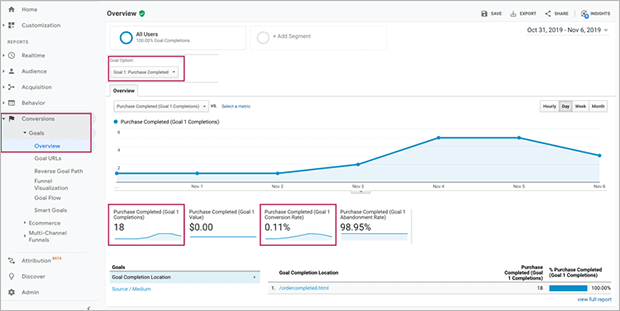
If you want to find your store’s conversion rate on Shopify, log in to your admin panel and go to the “Analytics” section.
Within the Analytics section, you’ll find a dashboard that provides an overview of various metrics, including your online store’s conversion rate, sessions, total sales, and more.
For a more detailed view, you can click on “View Report” to expand and explore additional insights.
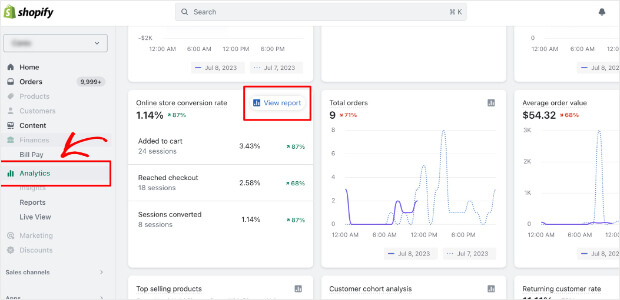
Explore these amazing Ways To Increase Your Shopify Store’s Conversion Rate.
Step 3 – Define the Conversion Goal
Within your tracking system, establish the conversion goal. This involves setting up a tracking event or creating a specific URL destination that signifies a successful conversion.
If you’re using Google Analytics, you’ll find various choices such as “Goals,” “eCommerce,” or “Multi-Channel Funnels” in the “Conversions” section. You can choose the option that aligns with the type of conversion you wish to track.
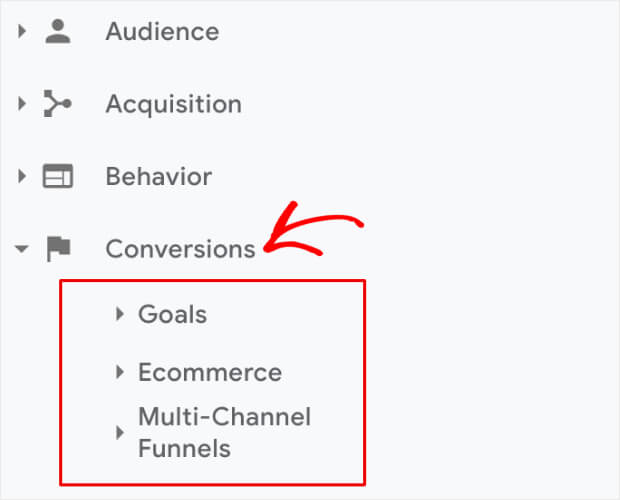
Step 4 – Finally, Calculate the Conversion Rate
To find the conversion rate, divide the number of conversions by the total number of visitors and multiply the result by 100 to get a percentage.
The formula looks like this:
Conversion Rate = (Number of Conversions / Total Number of Visitors) * 100
If you had 50 conversions out of 1000 visitors, the conversion rate would be:
Conversion Rate = (50 / 1000) * 100 = 5%
This means that 5% of your website visitors successfully completed the desired action.
Let us explain further using an example.
Suppose you have an eCommerce store that sells clothing. Your conversion rate would be the percentage of website visitors who make a purchase.
For instance, if 10,000 visitors visit your website in a month, and 500 of them make a purchase, your conversion rate would be 5% (500 divided by 10,000, multiplied by 100). This means that 5% of your website visitors are converting into customers.
Here are a few more specific formulas to provide you with a starting point for measuring conversion rates across different scenarios:
- Website Conversion Rate: (Number of Conversions / Total Number of Visitors) * 100
- Lead Generation Conversion Rate: (Number of Leads / Number of Visitors to a Page) * 100
- Lead Conversion Rate: (Number of Leads Converted / Total Number of Leads) * 100
- Sales Conversion Rate: (Number of Sales / Total Number of Leads) * 100
- Email Conversion Rate: (Number of Conversions / Number of Emails Sent) * 100
- Landing Page Conversion Rate: (Number of Conversions / Number of Landing Page Visits) * 100
- Click-Through Rate (CTR): (Number of Clicks / Number of Impressions) * 100
- Call-to-Action (CTA) Conversion Rate: (Number of Actions Taken / Number of CTAs Displayed) * 100
- Shopping Cart Abandonment Rate: (Number of Abandoned Carts / Number of Carts Created) * 100
What Is a Good Conversion Rate?
Determining what is a good conversion rate can vary depending on various factors, such as:
- industry,
- business type,
- target audience,
- and the specific action or goal being measured.
Generally, a good conversion rate is considered to be around 2% to 5%.
However, this is just a rough benchmark and should not be seen as a definitive standard.
Some industries with highly optimized websites and effective digital marketing strategies may achieve conversion rates exceeding 10% or more. At the same time, others may struggle to reach even 1%.
Average Website Conversion Rates by Industry
Below is a chart to give you a general understanding of conversion rates across various industries:
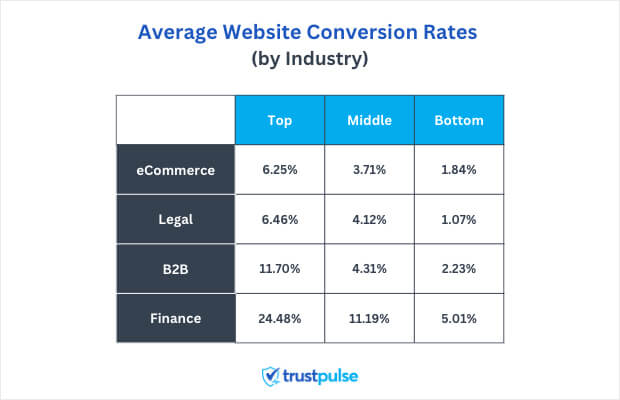
As you can see, conversion rates are relatively low in the eCommerce sector, especially when compared to the finance industry. Similarly, the top tier of finance conversion rates can reach as high as 24.48%.
A favorable conversion rate for lead generation websites (which aim to transform visitors into qualified leads) typically falls within the range of 10-15%. However, it’s possible to achieve even higher rates.
And if we talk about advertisement, WebFX found that the average conversion rate for Facebook ads is between 9-10%. In comparison, the average conversion rate for Google Ads is 7.04%.
But again, these rates serve as general benchmarks and cannot solely determine the success of a business.
Factors such as the size of the target market, average order value (AOV), and overall customer engagement also influence the profitability of a business.
For example, an eCommerce business with a 3.71% conversion rate may still generate more revenue than a legal services company with a 6.46% conversion rate.
Average eCommerce Conversion Rates
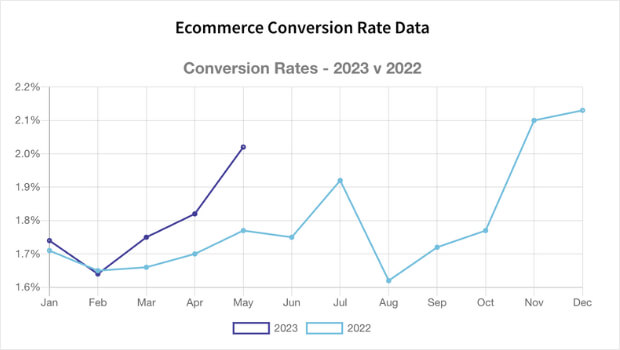
Recent studies show that a good conversion rate in the eCommerce market is typically around 2-3%. On the other hand, the average conversion rate increased by 14.17% from 1.77% to 2.02% in May 2023 compared to May 2022.
The chart below illustrates the significant differences in eCommerce conversion rate averages across various sectors:
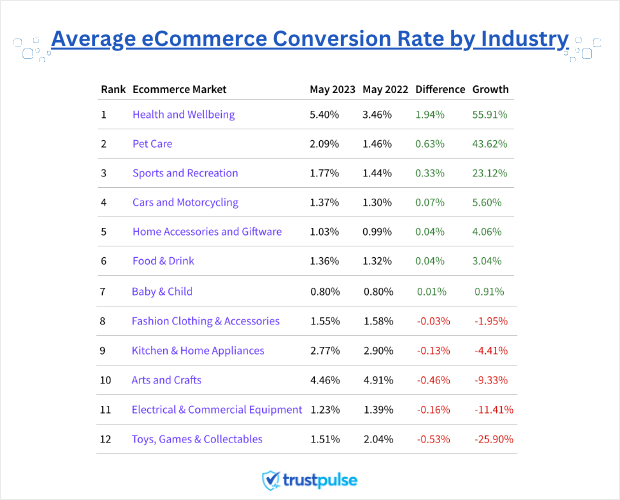
If we look at eCommerce conversion rates by industry, sectors like “Health and Well-being” and “Pet Care” have seen massive growth when comparing May 2023 to May 2022. Whereas the “Toys, Games & Collectables” sector decreased by nearly 0.53% from 2.04% to 1.51%.
When it comes to eCommerce email marketing, an average email conversion rate is somewhere between 8% to 9%. But certain types of emails, like abandoned cart emails, tend to convert much faster. And industries like retail generally convert more often than other industries.
P.S. Here are some Free Email Marketing Templates You Need To Try Right Now to enhance your online store’s email marketing efforts.
Remember that there are also some other variables that impact conversion rates, such as:
- Product type
- Product cost
- Traffic source
- Device (mobile, tablet, or laptop)
It’s also important to note that a good conversion rate is one that shows improvement compared to your previous performance. That’s why you should continuously optimize your website, refine marketing strategies, and test different approaches to increase conversion rates.
Check out these Actionable and Proven Tips to Increase Your eCommerce Website Conversion Rate now.
How to Improve Your Conversion Rate
Let’s look into the top 5 tips you can keep in mind to skyrocket your conversion rates:
1. User-Friendly Website
Having a website that is easy to navigate, visually appealing, and responsive across different devices is crucial. Providing a seamless and intuitive user experience can make it easier for visitors to find what they want and engage with your content. Ultimately, this leads to increased conversions, such as making a purchase or filling out a form.
Here are some of the key points for creating a user-friendly website:
- Intuitive Navigation: Make it effortless for visitors to find the information they’re looking for by implementing intuitive menus, breadcrumbs, and search functionality. Ensure every webpage can be accessed from the homepage with no more than 3 clicks.
- Responsive Design: Ensure your website is responsive and adapts to different screen sizes and devices. It should automatically adjust its layout, font sizes, and images to optimize readability and usability across smartphones, tablets, and desktops.
- Fast Loading Times: Visitors have little patience for slow-loading websites. Optimize your website’s performance by compressing images, minifying code, and leveraging caching techniques. Aim for fast loading times to prevent users from getting frustrated and abandoning your site. Tools like Google PageSpeed Insights can help you identify areas for improvement. Read What Is Average Time on Page and How to Increase It for more.
- Clear and Engaging Design: Use a visually appealing design that aligns with your brand identity and resonates with your target audience. Make effective use of the empty real estate, typography, colors, and imagery to create a pleasing and engaging user interface. Ensure that your design elements and content layout guide visitors’ attention toward important information and call-to-action buttons.
- Streamlined Conversion Process: Make it as simple as possible for visitors to complete desired actions, such as making a purchase, filling out a form, or signing up for a newsletter. Minimize the number of steps and form fields required, eliminate unnecessary distractions, and provide clear instructions throughout the conversion process. Use progress indicators to show users where they are in the process.
Resources:
- 10 Best Website Builders For Small Businesses Compared
- 9 Tips on How to Get Customers to Trust Your Website
- 11 Web Design Principles that Will Boost Your Conversion Rate
2. High-Quality Content
High-quality content is essential for attracting, engaging, and persuading your target audience. You can build trust and credibility with your visitors by providing valuable information and showcasing the benefits of your products or services.
Here’s a breakdown of the key aspects and strategies for producing high-quality content:
- Relevance and Value: Ensure your content is relevant to your target audience’s interests, needs, and pain points. Conduct thorough research to understand their challenges and provide solutions through your content. Offer valuable insights, tips, or advice that help them make informed decisions or improve their lives.
- Visual Elements: Incorporate relevant visual elements, such as images, infographics, or videos, to enhance the overall user experience. Visual content can help convey information more effectively, increase engagement, and make your content more shareable on social media platforms.
- SEO Optimization: Optimize your content for search engines to increase visibility and attract organic traffic. Conduct keyword research to identify relevant keywords and incorporate them naturally throughout your content. Write compelling meta titles and descriptions to encourage click-throughs from search engine result pages.
- Call-to-Actions (CTAs): Include relevant and persuasive CTAs within your content to guide visitors toward the desired actions. Whether it’s encouraging readers to subscribe, download, or purchase, strategically placed CTAs can significantly impact conversion rates.
Resources:
- 29 Impressive Content Marketing Examples You Can Use in 2023
- 51 Best Free Visual Content Creation Tools To Make Marketing Easy
- SEO Made Easy—Ultimate Guide to Explode Your Traffic In 2023
- 130+ Email CTA Examples That Can Boost Your Conversion Rate
3. A/B Testing and Optimization
A/B testing, or split testing, is a proven method to boost conversion rates. It involves comparing different versions of a webpage, campaign, or user experience to determine which performs better in achieving your desired goal. For example:
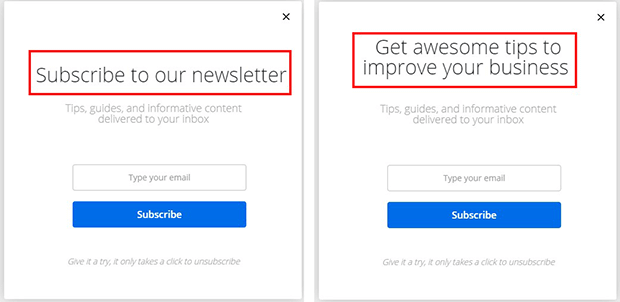
Here’s how it works:
- Create different versions of the element you want to test (such as web pages, emails, or ads). Each version should have a single distinct change.
- Randomly assign users or a segment of your audience to each variation.
- Run the A/B test simultaneously, ensuring that users in the same group experience only one version.
- Analyze the data to determine if there’s a significant difference in performance between the variations.
- Implement the better-performing version as the new default or make further optimizations based on the insights gained.
A/B testing enables data-driven decision-making, ensuring you refine your strategies and optimize your conversion funnel for better results.
Make sure to continuously test and optimize different campaigns to determine what resonates best with each audience segment.
It’s also worth noting that certain changes might lead to a decrease in conversion rates. In such cases, it’s essential to revert back to the previous approach that was yielding better results.
Resources:
- 60 A/B Testing Examples to Get You More Conversions
- 13 Dumb A/B Testing Mistakes That Are Wasting Your Time
- 11 Delightfully Simple A/B Testing Best Practices You Can Use Now!
4. Technical Issues
Technical issues can negatively impact user experience, decrease trust, and ultimately hinder conversion rates. That’s why you must address and resolve any technical problems or issues on your website. By identifying and rectifying these issues, you can provide visitors with a smooth and seamless browsing experience, increasing the likelihood of conversions.
Here are some of the key aspects and strategies for dealing with technical issues:
- Mobile Responsiveness: Test your website across different devices and screen sizes to ensure it displays properly and offers a better experience.
- Browser Compatibility: Ensure your website is compatible with all popular web browsers like Chrome, Firefox, and Safari. Test your website’s functionality and appearance across these browsers to ensure a consistent experience for all visitors.
- Broken Links and Redirects: Broken links can frustrate visitors and hinder navigation. Use tools like Google Search Console to identify broken links and update them accordingly. Additionally, ensure that any redirects you have in place are functioning correctly and don’t cause delays or errors.
- Security Measures: Implement proper security measures to protect your website and visitor data. Use HTTPS encryption to ensure secure communication between your website and users’ browsers.
- Error Handling: Implement user-friendly error handling to guide users when errors occur. Instead of displaying cryptic error messages, provide clear and helpful instructions on how to resolve the issue or contact support.
5. Social Proof
Social proof means that consumers adapt their behavior according to what other people do. It works on the principle that if others have had a positive experience or endorse a product or service, it must be valuable and trustworthy.
In marketing and sales, social proof refers to using positive feedback, testimonials, reviews, and social media validation to gain trust and credibility with potential customers.
Research shows that nearly 89% of consumers look at a product review before purchasing something online. And according to Nielsen’s Global Trust in Advertising report, consumers are 92% more likely to trust their peers over advertising when it comes to purchasing decisions.
So if you’re eager to boost your website conversions and skyrocket sales, embracing social proof is an absolute must.
And that’s precisely where TrustPulse comes to the rescue.
TrustPulse is the world’s #1 social proof plugin and software that brings social proof notifications to any website.
It lets you create small clickable pop-ups showing how others interact with your site in real time.
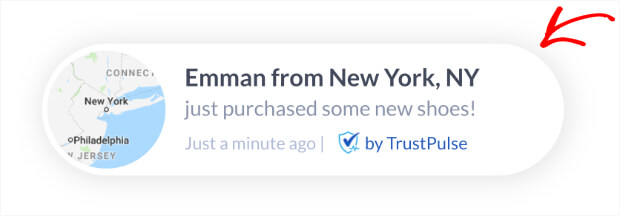
TrustPulse comes with four different campaign types that can be used in an endless number of ways:
- Recent Activity: Provide real-time notifications of recent customer activity on your website, like purchases, reviews, signups, and more.
- On-Fire: Show the number of people taking action on your website in a given period.
- Visitor Analytics: Highlight active interest in your site by a live visitor counter to your posts or pages.
- Action Message: Display a static notification to highlight information or encourage visitors to take action.
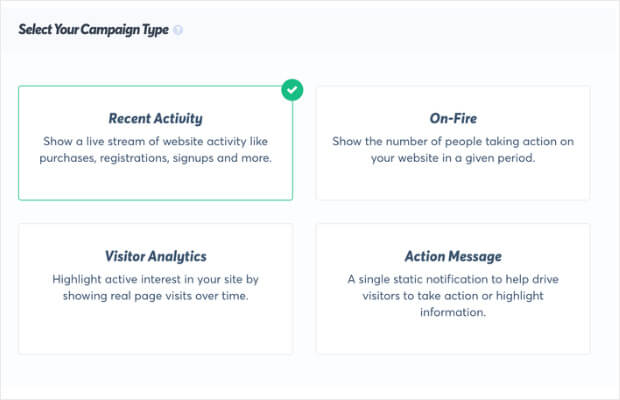
You can customize these notifications to match your site and brand perfectly with ZERO coding. The setup takes less than 5 minutes, with no complicated settings to waste your time.
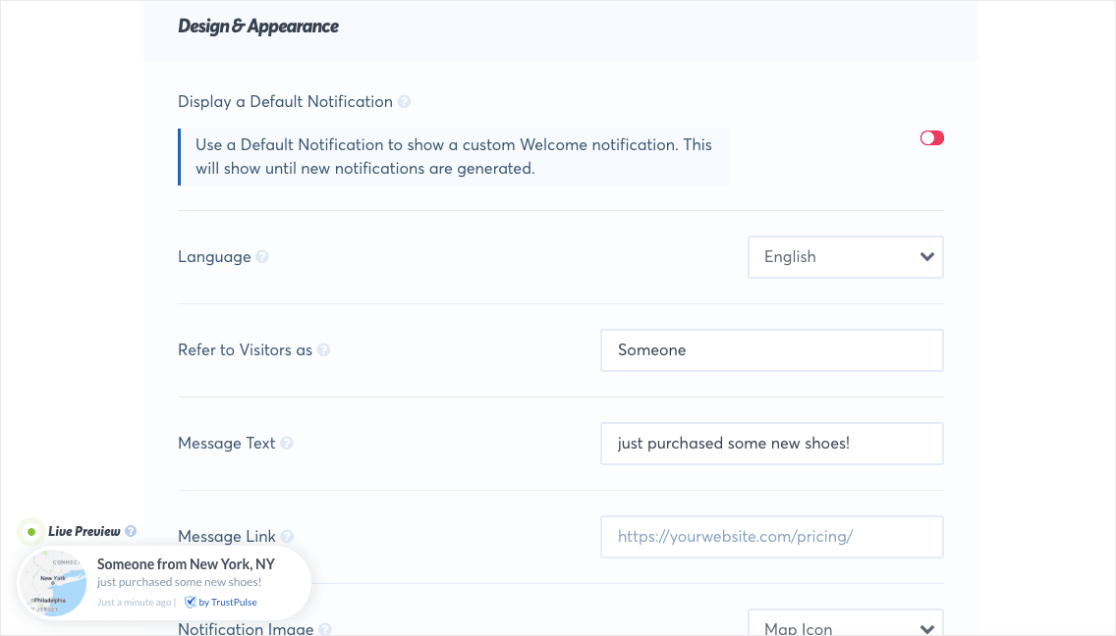
The best part is that TrustPulse integrates easily with all website platforms like WordPress, WooCommerce, Shopify, BigCommerce, and hundreds more.
And it comes with analytics to see which campaigns perform the best. This way, you can optimize your results and boost your campaign conversions.
Want to check it out? Sign up for your risk-free TrustPulse account to instantly increase site conversions by up to 15%!
For more tips on getting high conversion rates, read How to Increase Website Conversion Rate.
Conclusion: What’s a Good Website Conversion Rate?
And that’s all! We hope you liked this article.
Learning what constitutes a good conversion rate is crucial for measuring the success of your website’s performance.
While there is no one-size-fits-all answer, industry benchmarks, and your specific goals can provide valuable guidance.
Remember, the most important thing is continuous improvement and striving to optimize your conversion rate over time.
Monitor your metrics and test different strategies to drive better results. Leverage insights to achieve your desired conversion rates that align with your business objectives. And don’t forget to address any low conversion rates along the way.
If you want to learn more about conversion rates, consider checking out the following articles:
- Conversion Rate Optimization (CRO) Tools To Capture Leads
- Best Trust Badges To Boost Conversion Rates
- How to Determine (& Improve) Mobile eCommerce Conversion Rates
To take your conversion rate to the next level, try TrustPulse today and take advantage of our unconditional 14-day money-back guarantee!
